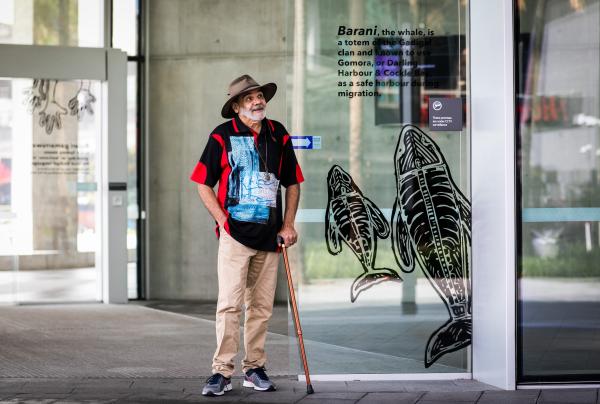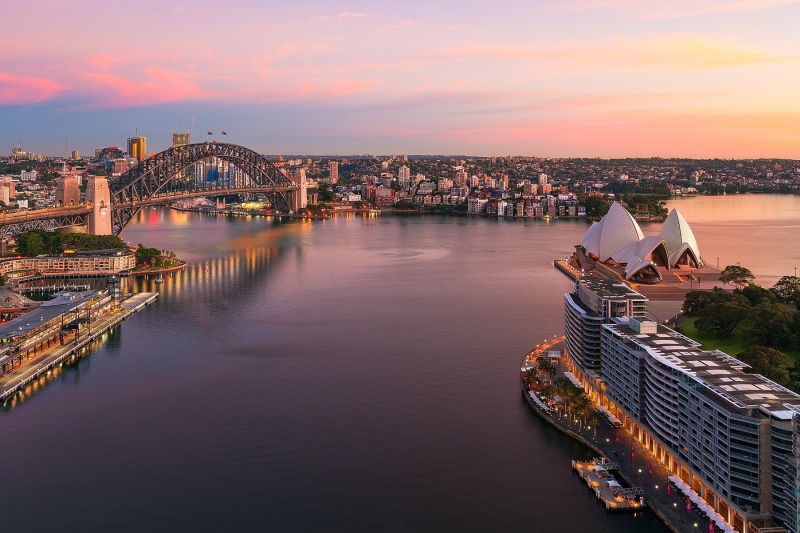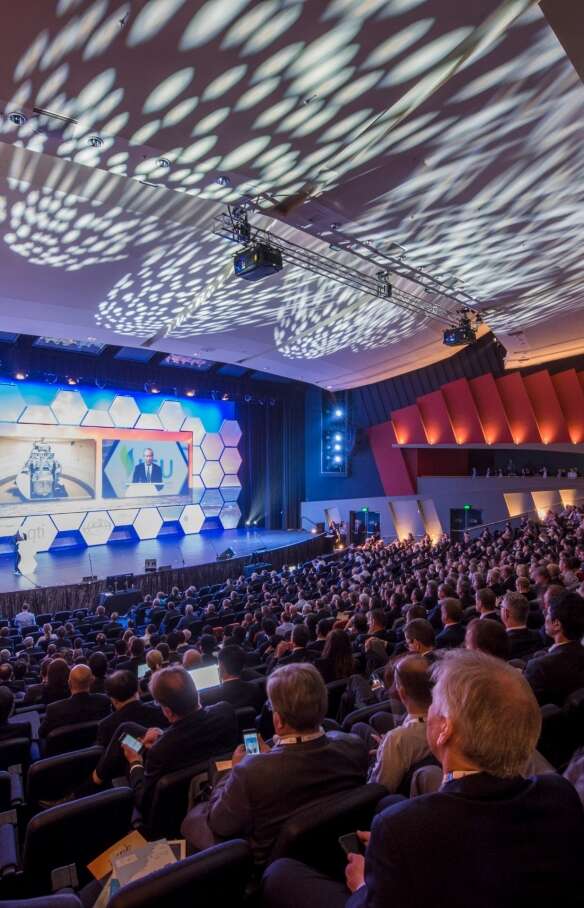
UNIQUE ARTWORKS OF AUSTRALIA’S CONVENTION CENTRES
To complement their outstanding conference and event facilities, Australia’s convention centres host some of the country’s most impressive artworks. We reveal the stories behind these signature works, which will add a splash of colour to a future business event.
ICC Sydney

Artwork by Indigenous artist Jeffrey Samuels at the ICC Sydney, Sydney, New South Wales. Photo © ICC Sydney
The ICC Sydney, which can accommodate 12,000 delegates at maximum capacity, is in a unique position to increase understanding and appreciation of First Nations cultures. This led the Centre to commission renowned Aboriginal artist, Jeffrey Samuels - whose works are exhibited at the prestigious National Gallery of Australia, Cambridge University, and the National Museum of Australia, amongst others - to create an artwork to signify to guests that they are on Gadigal land. Titled ‘Gadigal, Acknowledgement Respect’, the painting tells the story of how Australia’s First Nations people are connected to Sydney Harbour. The work depicts various flora, shells and animals of significance around the Harbour foreshore including the whale, which is a totem of the Gadigal clan. Delegates can admire the original painting, which is on display in Centre’s foyer, as well as elements of the artwork which are displayed prominently across main entry points of ICC Sydney.
THE LUME at the Melbourne Convention and Exhibition Centre

Van Gogh exhibition at THE LUME, Melbourne Convention and Exhibition Centre, Melbourne, Victoria. Photo © Melbourne Convention and Exhibition Centre
The first of its kind in Australia (and the Southern Hemisphere), THE LUME Melbourne in the Melbourne Convention and Exhibition Centre's South Wharf Precinct brings a permanent next generation digital gallery to the city’s already impressive arts culture. The 3,000 sqm (32,292 sq. ft) gallery has a capacity to entertain 200 to 1,200 guests with an immersive 360-degree sensory encounter powered by 150 state of the art projectors that display images to the height of 4-storeys. This expansive contemporary space can be booked for unforgettable events enhanced by cocktail functions, or a dinner designed and curated by the onsite team. THE LUME will burst onto the city’s arts scene in late 2021 with a multi-sensory journey through the works of Vincent Van Gogh.
Brisbane Convention and Exhibition Centre

Indigenous artwork on display in the Plaza Gallery, Brisbane Convention and Exhibition Centre, Brisbane, Queensland. Photo © Brisbane Convention and Exhibition Centre
Brisbane Convention and Exhibition Centre takes pride in supporting Australian Indigenous art and over the years has built one of Australia’s most significant collections of Central Desert Art. This museum quality collection of Indigenous art is currently on display in the Centre’s permanent art space – the Plaza Gallery. With cocktail and banquet capacity for 200 guests, this stunning space is available for corporate functions, private dining, and cocktail soirées. In fact, the world’s top dignitaries used this space as a place of retreat and private networking during the G20 Global Leaders' Summit in Brisbane in 2014, which was attended by 4,000 delegates and 2,500 media representatives. The neighbouring Plaza Ballroom (cocktail capacity for 2,000 guests) also hosts an impressive artwork, which happens to be one of the largest in Australia – a painting by the highly regarded Aboriginal artist, Dorothy Napangardi, that has been reproduced onto the Ballroom’s new carpet.
Adelaide Convention Centre

‘Wasteland Renewed’ installation by Danling Xiao, Mundane Matters, on display at the Adelaide Convention Centre, Adelaide, South Australia. Photo © Adelaide Convention Centre
To add a thought-provoking touch to an Adelaide business event, arrange a private group viewing of the large-scale ‘Wasteland Renewed’ installation which is currently on display at the Adelaide Convention Centre in South Australia. Comprising nearly 900 suspended orange spheres made from 120 kilograms of plastic marine debris collected from the Great Barrier Reef, this extraordinary installation delivers a strong message of sustainability. It challenges delegates to contemplate two of the world’s most urgent problems: plastic pollution and food waste. As well as evoking the spirit of renewal, Wasteland Renewed complements the Adelaide Convention Centre’s own sustainability initiatives; it's one of only two convention centres worldwide to have received EarthCheck’s coveted Platinum certification for best practice in business and environmental sustainability.
Perth Convention and Exhibition Centre

Artwork by Indigenous artist Chris Pease on display in the Central Foyer, Perth Convention and Exhibition Centre, Perth, Western Australia. Photo © Perth Convention and Exhibition Centre
Delegates arriving at the Perth Convention and Exhibition Centre (PCEC) are greeted by a magnificent piece of art which is intrinsically Western Australian. On display in the Central Foyer is an 18 metre (59 ft)-long artwork made from of 2,000 painted jarrah tiles, assembled similarly to a jigsaw. The design depicts the mythical Wagyl – the Noongar manifestation of the Rainbow Serpent - moving along the Swan River, which the PCEC overlooks today. The creation by Aboriginal artist Chris Pease was commissioned in 2004 and at the time was the biggest ever public art commission for a single artwork in Western Australian history. With capacity for up to 5,000 delegates over three levels, the PCEC features a 2,500-seat tiered auditorium, two grand ballrooms and 19 meeting rooms, providing a range of options for a future business event in the beautiful city of Perth.
Gold Coast Convention and Exhibition Centre

‘Silk Road’ artwork by Paul D Johnson and Gail Mason on display in Halls Foyer, Gold Coast Convention and Exhibition Centre, Gold Coast, Queensland. Photo © Gold Coast Convention and Exhibition Centre
In Queensland’s Gold Coast, most artworks on display around the Gold Coast Convention and Exhibition Centre (GCCEC) follow a collective theme; designed as a testament to the venue’s surroundings and the traditional owners of land, the Kombumerri People of the Yugambeh group. The pieces are intended to be consistent with the design and architecture of GCCEC, thus inviting delegates to reflect on the significance of the site on which the building stands. This journey through the heritage and landscapes of the Gold Coast leads guests to the latest piece to adorn the Centre, titled ‘Silk Road’. This impressive sculpture by Paul D Johnson and Gail Mason creates a startling juxtaposition to the overarching theme. A tribute to China’s famous Silk Road trading route, it represents the ancient and endless cycle of trade across the globe. Delegates can enjoy dinner and drinks in the presence of this remarkable aluminium and dichroic glass creation which hangs from the ceiling of the Halls Foyer, which has capacity for 400 people for a banquet or 1,000 guests for a cocktail function.
Cairns Convention Centre

Artwork by Indigenous artists Nancy and Ned Beeron and Desley Henry on display in the Ground Level Foyer, Cairns Convention Centre, Cairns, Queensland. Photo © Cairns Convention Centre
At the Cairns Convention Centre, delegates can admire an array of fascinating works which represent the natural beauty and history of Tropical North Queensland. One such work is a unique collection of bicornual cane baskets, known as ‘jawun’, created by Nancy and Ned Beeron and Desley Henry from the Jumbun Aboriginal Community. The distinct style of the baskets is exclusive to the people of the rainforest area from Cooktown in the north to Cardwell in the south. Jawun have a variety of purposes: they are used for carrying heavy loads; as fish traps in rivers where the horns of the baskets allow them to be wedged between sticks or rocks; and as sieves to leach out toxic substances from a variety of bush food. Guests can marvel at these striking creations which are on display in the Ground Level Foyer, adjacent to the Auditorium which accommodates up to 2,300 delegates in tiered theatre style, 1,720 cocktail-style and 1,200 for a banquet.
Published: 22 October 2021

















